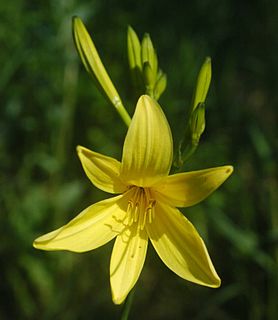
A daylily or day lily is a flowering plant in the genus Hemerocallis, a member of the family Asphodelaceae, subfamily Hemerocallidoideae. Despite the common name, it is not in fact a lily. Gardening enthusiasts and horticulturists have long bred daylily species for their attractive flowers. Thousands of cultivars have been registered by local and international Hemerocallis societies.

The Pacific golden plover, or Pacific golden-plover is a medium-sized plover. The genus name is Latin and means relating to rain, from pluvia, "rain". It was believed that golden plovers flocked when rain was imminent. The species name fulva is Latin and refers to a tawny colour.
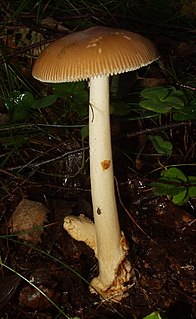
Amanita fulva, commonly called the tawny grisette, is a basidiomycete mushroom of the genus Amanita. It is found frequently in deciduous and coniferous forests of Europe, and possibly North America.

The cave swallow is a medium-sized, squarish tailed swallow belonging to the same genus as the more familiar and widespread cliff swallow of North America. The cave swallow, also native to the Americas, nests and roosts primarily in caves and sinkholes.

Hemerocallis fulva, the orange day-lily, tawny daylily, corn lily, tiger daylily, fulvous daylily or ditch lily, is a species of daylily native to Asia. It is very widely grown as an ornamental plant in temperate climates for its showy flowers and ease of cultivation. It is not a true lily in the genus Lilium, but gets its name from the superficial similarity of its flowers to Lilium and from the fact that each flower lasts only one day.
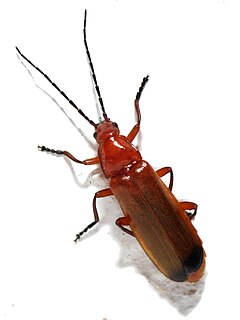
The common red soldier beetle, also misleadingly known as the bloodsucker beetle, and popularly known in England as the Hogweed Bonking Beetle is a species of soldier beetle (Cantharidae).
Vernaya is a genus of rodent in the subfamily Murinae from southern China and northern Burma. It contains a single extant species, the red climbing mouse, and several extinct species, all described by Zheng in 1993, namely Vernaya prefulva, Vernaya pristina, Vernaya giganta and Vernaya wushanica. The genus is named after Arthur Stannard Vernay who collected the specimen of V. fulva on an expedition to Burma with Charles Suydam Cutting.

The red climbing mouse, also known as Vernay's climbing mouse, is a species of rodent in the family Muridae. It is named after explorer and antiques dealer, Arthur Vernay, who sponsored the expedition during which the animal was first discovered. It is the only living species in the genus Vernaya, and has no subspecies.
The fulvous wren is a species of bird in the family Troglodytidae. It was formerly considered a subspecies of Cinnycerthia peruana. As presently defined, the fulvous wren is found in dense undergrowth of humid Andean forests in Bolivia and southern Peru.
Fulvous is a colour, sometimes described as dull orange, brownish-yellow or tawny; it can also be likened to a variation of buff, beige or butterscotch. As an adjective it is used in the names of many species of birds, and occasionally other animals, to describe their appearance. It is also used as in mycology to describe fungi with greater colour specificity, specifically the pigmentation of the surface cuticle, the broken flesh and the spores en masse.

The tawny crazy ant, Nylanderia fulva, is an ant originating from South America. Like the longhorn crazy ant, this species is called "crazy ant" because of its quick, unpredictable movements. It is sometimes called the "Rasberry crazy ant" in Texas after the exterminator Tom Rasberry, who noticed that the ants were increasing in numbers in 2002. Scientists have reorganised the genera taxonomy within this clade of ants, and now it is identified as Nylanderia fulva.

Cephalopholis fulva, the coney or the butterfish, is a species of marine ray-finned fish, a grouper from the subfamily Epinephelinae which is in the family Serranidae which also includes the anthias and sea basses. It is found in the western Atlantic. It is associated with reefs and is a quarry species for commercial and recreational fisheries. It can be found in the aquarium trade.
The Brachypsectridae are a family of beetles commonly known as the Texas beetles. There are only two extant genera, Brachypsectra and Asiopsectra. The type species, Brachypsectra fulva, occurs in North America. Other species in the genus have a cosmopolitan distribution. Two other extant and fossil species have been described from the Dominican Republic. While formerly considered monogeneric, in 2016 Asiopsectra was described from specimens found in Iran and Tajikistan. Two extinct genera, Vetubrachypsectra and Hongipsectra, known from adults, and a larval genus, Cretopsectra are known from Cenomanian aged Burmese amber.

Louisiana iris is a taxonomic group of five iris species native to Louisiana and surrounding regions of the southeastern United States: Iris fulva, Iris hexagona, Iris brevicaulis, Iris giganticaerulea, and Iris nelsonii.
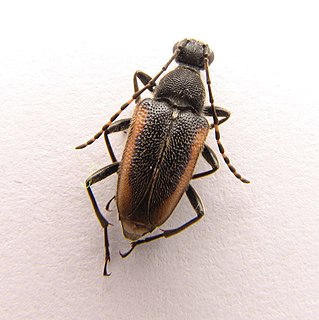
Brachyleptura champlaini is a species of beetle in the family Cerambycidae. It was described by Casey in 1913.
Brachyleptura circumdata is a species of beetle in the family Cerambycidae. It was described by Olivier in 1795.
Brachyleptura pernigra is a species of beetle in the family Cerambycidae. It was described by Linell in 1897.
Brachyleptura vexatrix is a species of beetle in the family Cerambycidae. It was described by Mannerheim in 1853.

Aphaenogaster fulva is a species of ant in the family Formicidae.
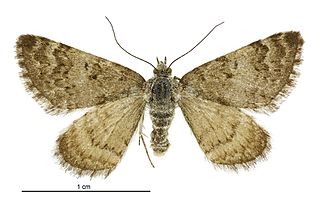
Paranotoreas fulva is a species of moth in the family Geometridae. This species is endemic to New Zealand. It is classified as "At Risk, Relict" by the Department of Conservation.













